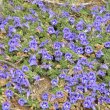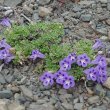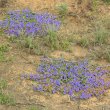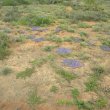Aptosimum procumbens
| Botanical Name | Aptosimum procumbens |
|||||||||||
| Family | Scrophulariaceae - The snapdragon family. |
|||||||||||
| Pronunciation | ap-TOE-sih-mum pro-KUM-benz |
|||||||||||
| Common Name(s) |
English: Karoo Violet; Wild Violet; Carpet Flower; Karoo Carpet Flower; Veld Violet; Violet-of-the-karoo
Afrikaans: Brandblare; Brandbossie; Kankerbos; Karooviooltjie; Seeroogbossie
|
|||||||||||
| Plant Group |
|
|||||||||||
| Plant Size |
|
|||||||||||
| Position |
|
|||||||||||
| General Information |
|
|||||||||||
| Specific Information | Aptosimum procumbens is a low growing perennial plant which spreads to form a mat of up to 1 m in diameter. The leaves are usually densely crowded on long or short shoots and vary in shape from roundish to narrow. The fruit is a capsule with an opening at the top from which seeds escape. The plant can withstand long periods of drought. When in full bloom it is covered with dark blue or violet, trumpet-shaped flowers that can appear at any time of the year but mostly from spring to summer, after rain. Karoo violets show potential as garden plants especially in the dry parts of the country, where carpets of purple brighten the arid landscape. Unfortunately this little plant appears to have escaped the notice of horticulturists and is not commercially available. |
|||||||||||
| Ad Break | ||||||||||||
| Flowers | ||||||||||||
| Description | trumpet-shaped with a white throat and dark purple markings at the base of the lobes |
|||||||||||
| Season |
|
|||||||||||
| Colour |
|
|||||||||||
| Growth Rate |
|
|||||||||||
| Plant Uses |
|
|||||||||||
| Distribution and Habitat | in the arid areas the Western Cape, Eastern Cape, Free State, Northern Cape and the North West Province, including Namaqualand, Bushmanland, the Great Escarpment, the Northern, Upper, Great and Little Karoo, as well as in Namibia and Botswana, on flood plains, flats, ridges, disturbed ground and mountain plains |
|||||||||||
| Planting Suggestions | It is reportedly difficult to propagate Aptosimum procumbens from seed which is possibly a reason for its lack of application in the nursery trade. If you can gain access to them, cuttings taken only from the soft, young tips of shoots are a better option. Use material from healthy and vigorously growing plants. Cuttings should be about 10 cm long and be planted in a coarse, sandy soil which must be kept moist and warm. Poorly drained soil will cause the cuttings to rot. |
|||||||||||
| Lorraine's Garden Notes | The second and fourth photo are the property of Kwandwe Private Game Reserve near Grahamstown. |
|||||||||||
| Medicinal Uses | The plants are said to be of medicinal value to treat 'krimpsiekte' in sheep, an illness that affects the joints, muscles and stomach, often resulting in starvation and death. |
|||||||||||
| Ad Break | ||||||||||||









Comments
Propogating Aptosimum procumbens
I have a large piece of land in Oudtshoorn, more than half of which is wild veld. Aptosimum procumbens grows wild and prolifically on this untouched land, which is composed mostly of heavy red clay and dense loam. If it grows wild in such soil is it really necessary to propagate it in the light, well-drained mixture you suggest?
Propagating Aptosimum procumbens
Hi Charnell
My apologies for taking so long to reply to you comment.
I hear what you are saying but I have never had any luck trying to root tender young cuttings in clay or heavy soil. Soft tip cuttings need to be kept just moist with plenty of air in the soil and around the stems. Clayey and heavy soils do not serve the purpose as the dense particles clamp tightly onto the delicate stems, keeping them constantly wet, with the result that the cuttings rot within a couple of days.
Once the cuttings in the light soil are well rooted, they are steadily hardened off until they are strong enough to be planted in a harsher environment.
Sadly, I have never been able to obtain seeds or cuttings of this delightful little plant.
Kind regards
Lorraine
Propagating Aptosimum procumbens
To find the 1cm cuttings spoken of in the article you will have to be very diligent. Very rarely will you find such cuttings and only in spring when the first rain and signs of heat have prompted some growth. I have never really considered taking cuttings before reading this article, being quite content to wander up the slope behind our house to admire the wonderful variety of succulents and other veld flowers that grow there. I have however noted a spurt of growth around September and October. New growth tends to harden off extremely quickly by the looks of it and unless you have unlimited free access to a growing plant near you, you are going to find it near impossible to get cuttings.
Propagating Aptosimum procumbens
Hi Charnell
Many thanks for your detailed information. It looks as though it would be very difficult to get hold of this little plant. I have found that many of the little veld plants just don't perform when grown in a garden situation and I suspect this is one of them. The specific needs of climate, habitat and soil would be difficult to provide. I'll just have to enjoy my pictures and memories.
Kind regards
Lorraine
Discuss this plant
Share knowledge, ask a question or give an experience.